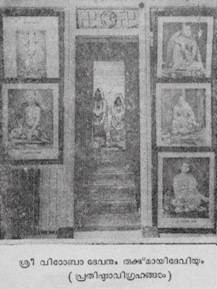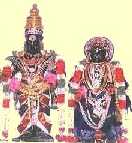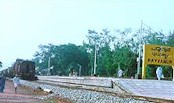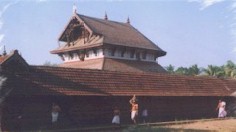 This temple at
Payyannur in the Kannur district. It was established in 1974. The main prathishta is
Vittoba Rukmini. The temple and prathista are facing the west. There are
sila vigrahas and panchaloha vigrahas of Vittoba and Rukmini
installed in the srikovil. The sila vigrahas were made by the famous sculptor
Karkal Sriranjal Gopalakrishna Shenoy. This temple at
Payyannur in the Kannur district. It was established in 1974. The main prathishta is
Vittoba Rukmini. The temple and prathista are facing the west. There are
sila vigrahas and panchaloha vigrahas of Vittoba and Rukmini
installed in the srikovil. The sila vigrahas were made by the famous sculptor
Karkal Sriranjal Gopalakrishna Shenoy.
It is believed that Sree Vittal or Vithoba is
Naada Murthi and is fond of bhajans and He does not need other poojas. So, bhajans are
conducted regularly in the temple. Vaisakha Pournami festival, Ashada Ekadashi, Bhajana
(recital of slogans of gods’ likings), Karthika Ekadashi Bhajana, Karthika Panchami,
Uthana Dwadasi, Sree Varamahalaxmi Vritham (fast) are the festivals and major ceremonies
conducted.
The divine “Shami Vriksha Katte” in the
temple premises is a great craze for devotees. The worship of this tree fulfils the wishes
and remove obstacles encountered, the devotees testify. It is believed that the Raksha
Charadu (safety thread) worshipped at the feet of the Lord Vithoba and goddess Rukmai
ensures solace and prosperity to the devotees who wear it.
History
The gsb members in Payyannur formed a Bhajan
group in 1924 and installed pictures of Vittoba and Rukmini in a room offered by Sri.
Anantha Shenoy above his business establishment at Payyannur.
 Weekly bhajans was offered on
every Saturday and on Ekadashi days. Later, a common Bhajan Mandir was constructed by the
community and poojas started installing idols of Vittoba Rukmini. Sri Vaijappa Narayan
Bhandari, a business man from Mangalore, donated a marble statue of Sri Krishna (about 1.5
ft) to the Mandir for worship. Weekly bhajans was offered on
every Saturday and on Ekadashi days. Later, a common Bhajan Mandir was constructed by the
community and poojas started installing idols of Vittoba Rukmini. Sri Vaijappa Narayan
Bhandari, a business man from Mangalore, donated a marble statue of Sri Krishna (about 1.5
ft) to the Mandir for worship.
In 1951, during his visit to Payyannur,
Srimat Sudheendra Tirtha Swamiji stressed the need for constructing a community temple at
Payyannur. Since the location of the present Bhajan Mandir was not suitable, Swamiji
directed that a suitable location has to identified for construction of the temple. A
committee headed by Vasudeva Shenoy was formed and they raised fundsby way of monthy
subscriptions and donations from community members and businessmen. It took about 18 years
to materialise the dream. The land for construction of temple was purchased from Sri.
Anantha Prabhu in 1970 and the construction work started under the leadership of Sri.
Upendra Shenoy. A marriage hall (Sukrathindra kalamandir) was constructed next to the
temple and was inaugurated in 1975 by Srimat Sudheendra Tirtha Swamiji.
The concrete roofing of the sanctum sanctorum has
been changed to copper sheet roofing in 1998.
The temple governance is by a committee elected
locally from the community members. There are about 100 gsb families in payyannur.
Story of Vittoba-Rukmini
 Vittoba is a form of Krishna,
the name Vittoba means Father Vittala. The Vithoba-Rukmini are the Divine
couple. Of Krishna's eight wives, Rukmini is considered to be his most favourite and
beloved because of her satvic character and her devotion to Him. The story of
Rukimini's marriage to Lord Krishna is a very interesting love story. Rukmini's father,
the king of Vidarbha, decided to give away Rukmini in marriage to Shishupala, the king of
Chedi. Her brother also consented to the marriage and the wedding preparations were in
full force. Rukmini, however was in love with Krishna even from her younger age because
she heard so much of His virtues. To escape her pre-arranged marriage to Shishupala, she
sent one of her confidants to Krishna with a message. Krishna along with Balarama came
down to Vidarbha and took away Rukmini in a chariot and killed Shishupala in the battle
followed. On reaching Dwaraka He married Rukmini. Vittoba is a form of Krishna,
the name Vittoba means Father Vittala. The Vithoba-Rukmini are the Divine
couple. Of Krishna's eight wives, Rukmini is considered to be his most favourite and
beloved because of her satvic character and her devotion to Him. The story of
Rukimini's marriage to Lord Krishna is a very interesting love story. Rukmini's father,
the king of Vidarbha, decided to give away Rukmini in marriage to Shishupala, the king of
Chedi. Her brother also consented to the marriage and the wedding preparations were in
full force. Rukmini, however was in love with Krishna even from her younger age because
she heard so much of His virtues. To escape her pre-arranged marriage to Shishupala, she
sent one of her confidants to Krishna with a message. Krishna along with Balarama came
down to Vidarbha and took away Rukmini in a chariot and killed Shishupala in the battle
followed. On reaching Dwaraka He married Rukmini.
One day it so happened that Lord Krishna, while
feeling lonely, was reminded of his early days in Mathura. He particularly remembered his
love, Radha. Though she was dead, he longed to see her again. By his divine powers he
brought her back to life and seated her by his side. Just then his queen, Rukmini, entered
the room. When Radha did not rise to pay her respect, Rukmini left Dwarka in anger and hid
herself in Dandirvan forest.
Lord Krishna set off in search of Rukmini. He first went to Mathura,
then to Gokul. He met the cowherd boys and they too joined in the search. They went to
Mount Govardhan in her search and reached the banks of the river Bhima in the Deccan.
Krishna justify his companions at Goplapura, and he entered Dandirvan forest alone in
search of her. At last he found her and managed to calm her.
Krishna and Rukmini came to Pundalik's ashram. But at that time Pundalik was busy
attending to his parents. Though he knew Lord Krishna had come to see him, he refused to
pay his respect to the god before his duty towards his parents was done. He, however,
threw a brick outside for lord Krishna to stand upon. Impressed by Pundalik's devotion to
his parents, Lord Krishna did not mind the delay. Standing on the brick he waited for
Pundalik. When Pundalik came out and begged God's pardon, Lord Krishna replied that far
from being displeased, he was pleased with his love for his parents.
Lord Krishna then ordered His worship on Vithoba, or God who stood upon a brick. An
imposing temple was built at the place (Pandharpur in Maharastra) where Krishna and
Pundalik had met. Inside the temple stands Krishna's image on a brick with image of
Rukmini on his side.
About
Payyannur click for Kannur district map
 Payyanur is
situated in the Kannur district of Kerala. The place derives its name from the renowned
Sri Subrahmanya Swami Temple located here. 'Payyan' is an appellation of Lord Subrahmanya
and ‘Ooru' means the place. Thus Payyanur means the land of Lord Subrahmanya.
Payyanur is also well known for Pavithra Mothiram, Astrology, Art forms like Theyyam and
Poorakkali. Payyanur is
situated in the Kannur district of Kerala. The place derives its name from the renowned
Sri Subrahmanya Swami Temple located here. 'Payyan' is an appellation of Lord Subrahmanya
and ‘Ooru' means the place. Thus Payyanur means the land of Lord Subrahmanya.
Payyanur is also well known for Pavithra Mothiram, Astrology, Art forms like Theyyam and
Poorakkali.
Subrahmanya temple
 Sree Subrahmanya Swami
Temple of Payyanur is believed to be constructed by Lord Parasurama, the incarnation of
Lord Vishnu. In Brahmanda Purana the temple and its town is being mentioned while
Muni Garga explains about Kerala to Pandavas during their exile. This temple was
destroyed two times. Once due to a fire and then during the attack of Tipu Sultan of
Mysore The temple was reconstructed in the present form in 1792 AD. The two-storied
sreekovil (sanctum sanctorum) is in the shape of “Gajaprishta” (back of an
elephant). The idol of the main deity Lord Subrahmanya is about 6-ft tall . The
“Ilanji” tree in the front-yard of the temple remains a surprise to all devotees
since this tree always flowers but never fruits. Sree Subrahmanya Swami
Temple of Payyanur is believed to be constructed by Lord Parasurama, the incarnation of
Lord Vishnu. In Brahmanda Purana the temple and its town is being mentioned while
Muni Garga explains about Kerala to Pandavas during their exile. This temple was
destroyed two times. Once due to a fire and then during the attack of Tipu Sultan of
Mysore The temple was reconstructed in the present form in 1792 AD. The two-storied
sreekovil (sanctum sanctorum) is in the shape of “Gajaprishta” (back of an
elephant). The idol of the main deity Lord Subrahmanya is about 6-ft tall . The
“Ilanji” tree in the front-yard of the temple remains a surprise to all devotees
since this tree always flowers but never fruits.
Hanumarambalm
Shree Raghavapuram is situated in the valley of
Cheruthazham village near Payyanur town, opposite to the hills of 'Ezhimala'. Though
the place had been named as Sree Raghavapuram, it is popularly known as
'Hanumarambalm'. There is a small beautiful Sree Rama temple here which is one of
the most ancient and famous Vaishnava temples of northern Kerala. The original
temple is believed to have been built by Mooshaka dynasty centuries ago and later Sri
Udaya Varma Kolathiri during his rule had renovated the temple in the 8th Century. The
main temple where idol of Sree Ramachandra was originally installed was east facing.
As per the ancient annotation the original idol of Sree Ramachandra was depicting the mood
of the Lord as was during the Rama-Ravana battle. It was felt that, the population
residing on the Eastern side of the temple were experiencing lot of hardship due to this
mood of the prathista.
 On
conducting 'prashnam' it was decided to open a doorway for the temple on the western side
facing 'Ezhimala', and to shut the doorway facing eastern side and also to reinstall Sree
Ramachandra with Sita Devi along with brother Lakshman. It is believed while Sree
Hanuman was carrying the Mountain with Mridhasanjeevani to Lanka, a piece of the mountain
broke and fell down at this place (where the temple is located) and thus the 'Ezhimala'
was formed. Sree Hanuman's temple is located inside the 'Naalambalam' at the 'Vaayu
moola' (Northwest corner). It is believed that Sree Rama had devoted the name of His
temple itself in the name of His Baktha, as 'Hanumarambalam'. On
conducting 'prashnam' it was decided to open a doorway for the temple on the western side
facing 'Ezhimala', and to shut the doorway facing eastern side and also to reinstall Sree
Ramachandra with Sita Devi along with brother Lakshman. It is believed while Sree
Hanuman was carrying the Mountain with Mridhasanjeevani to Lanka, a piece of the mountain
broke and fell down at this place (where the temple is located) and thus the 'Ezhimala'
was formed. Sree Hanuman's temple is located inside the 'Naalambalam' at the 'Vaayu
moola' (Northwest corner). It is believed that Sree Rama had devoted the name of His
temple itself in the name of His Baktha, as 'Hanumarambalam'.
|
